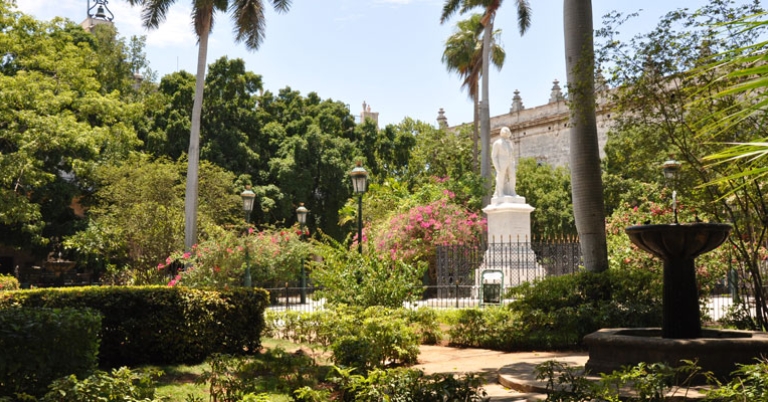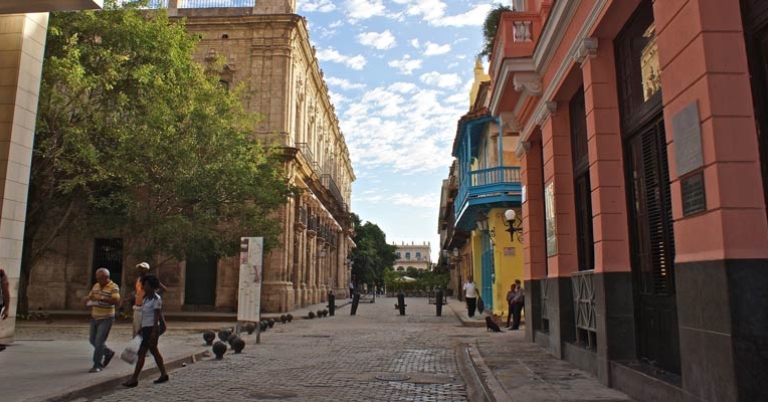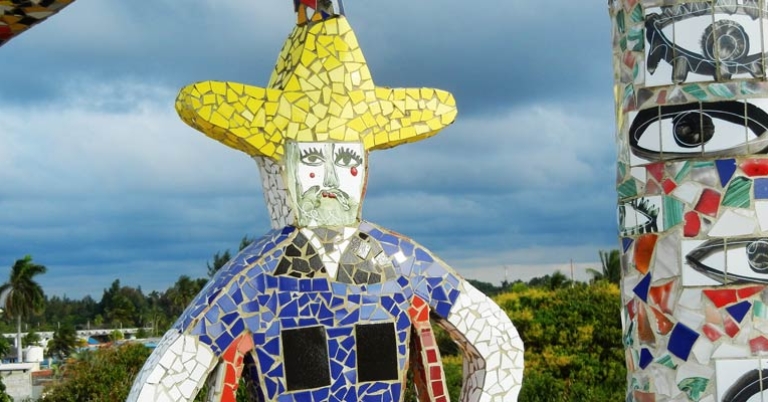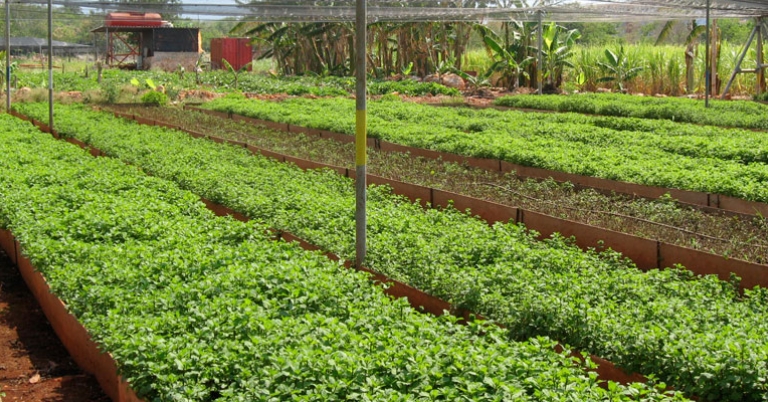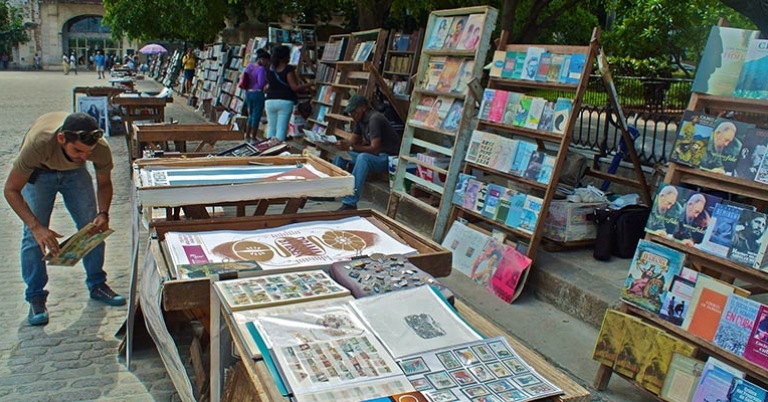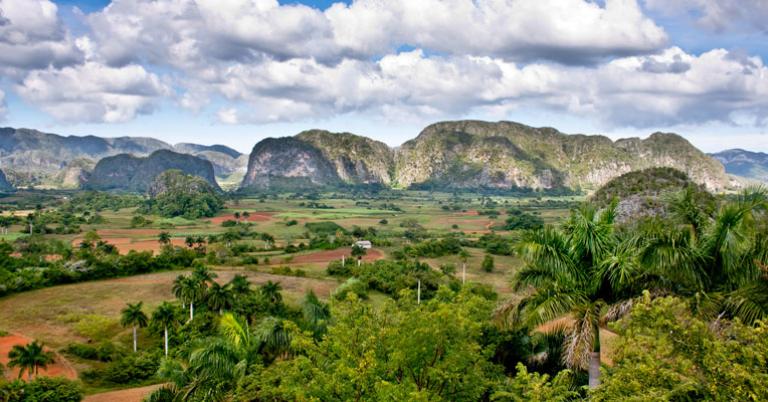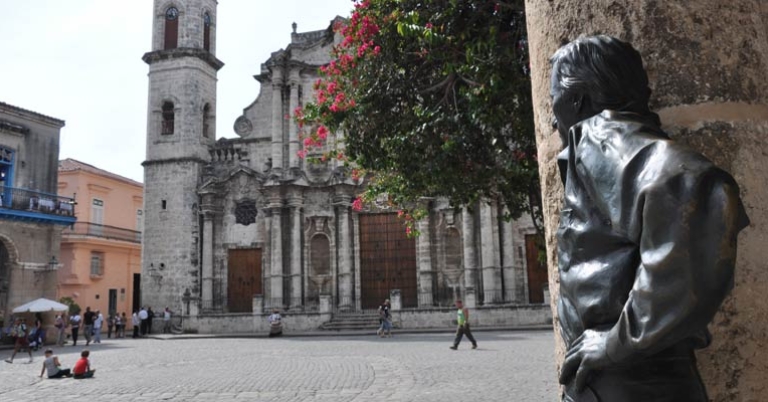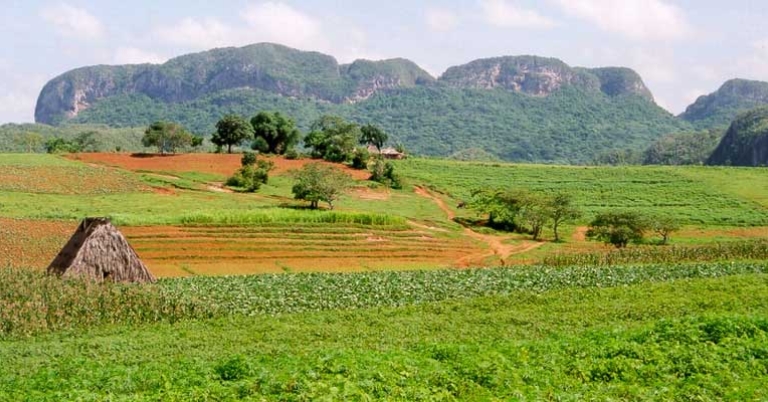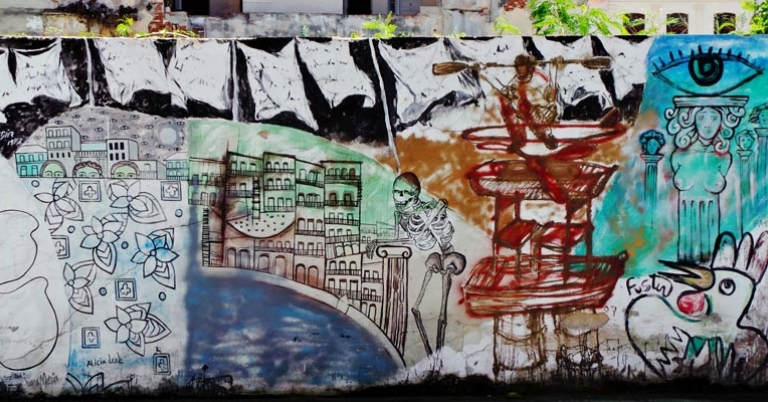Exploring Cuba with Mike Curry
About this trip
Journey to Havana, Cuba and explore the world of Ernest Hemingway and his life in this amazing island which he called home. Using the lens of Hemingway’s novels To Have and Have Not and The Old Man and the Sea, author and Hemingway scholar Michael Curry will lead our journey through the city's complex past and present. We will explore La Habana Vieja (Old Havana), walking through the amazing architecture of monuments, fortresses, churches, and plazas. We will visit the small fishing village of Cojímar, the setting for Hemingway’s The Old Man and the Sea. We will see the Cuban countryside in picturesque Viñales Valley for a deeper understanding of the region's geology, agriculture, and history. Through our visits to artist studios and community projects together with Michael’s longtime Cuban friends, Osmeivy Ortega and others, we will learn about Cuba today and the remarkable resilience of the Cuban people.
"At a point about halfway across the Gulf Stream, on a passage from Key West to Havana on a clear night with calm waters, you can look back from where you have come and see the glow of the lights from Key West. If you look forward at that moment to where you are headed, you can see the glow of Cuba and know you are on a true course to Havana. The fact these two islands are connected in such an ethereal way symbolizes the spiritual and cultural bond between them. Of course, there is a point where the glow from Key West fades, and the glow from Havana strengthens. Ernest Hemingway lived happily in Key West until he sensed and then saw the glow of Cuba. This is a story of his two island homes and the cultures and people who shaped his life and writing for over 30 years." (Hemingway: Between Key West and Cuba. Directed by C. Michael Curry and Raúl Villarreal, 2021)
Highlights
- Explore Havana through the lens of Ernest Hemingway, who called this place home from 1940 to 1960.
- Travel with Michael Curry, Hemingway scholar, author, and Cubaphile, to explore key landmarks and cultural sites.
- Experience the intense visual beauty of Havana in all its decadence, beauty and history. Enjoy a walking tour with Jaime Rodríguez, one of the three architects who initiated, in the early 1980s, the project to restore Old Havana.
- Learn about Afro-Cuban religious culture by experiencing the music and ceremony in a local home of musicians in the community of Regla.
- Take a day trip to Viñales Valley in the country's rural heartland, home to the remarkable limestone hills known as mogotes, and learn about the importance of tobacco in Cuban culture and history.
- Experience the contemporary art thriving throughout Havana. Osmeivy Ortega, friend of Michael and visual artist, will guide you through visits to several artists’ studios. At Casa Fuster, you will see the work of an artist who helped transform his neighborhood with tile work and other installation work.
NOTE: It is not necessary to be a Hemingway fan to enjoy this program, but it will add to the experience. Participants will be encouraged to read Hemingway’s works To Have and Have Not and The Old Man and the Sea, as well as Black Witch Moth: A Man's Spiritual Journey to Find His Destiny by C. Michael Curry (2022).
Meet your leader
 C. Michael Curry
C. Michael Curry
Michael Curry grew up in Key West, Florida, hearing stories from his grandfathers, who knew Ernest Hemingway. His grandfather on his father's side was born on Green Turtle Cay, Abaco, in the Bahamas, and worked at the Key West Citizen, the local daily newspaper. Hemingway would come to the Citizen to check the wire for the day's news and to discuss news and current events with the newspaper's owner and editor. It was no small coincidence the newspaper in those days was located directly across from Sloppy Joe's Bar.
Michael's grandfather on his mother's side was a charter boat captain in Key West and a Bra Saunders and Joe Russell contemporary. His connection to Hemingway resulted from being around the docks where Saunders, Russell, and other party boat captains kept their boats. His recollections included conversations between the captains, the mates, and the writer on topics ranging from fishing to politics and the art of making a living from the sea.
Michael's grandmother on his father's side was born in Guanabacoa, Cuba, and spending time with her gave him a unique perspective on the connections between Cuba and Key West as he grew up. His great-grandparents, grandparents, and parents were and are Conchs.
Michael has co-written and co-produced a documentary on Hemingway titled "Hemingway: Between Key West and Cuba." In addition, he co-wrote and presented a paper on Hemingway in Cuba titled "The Picador and the Prisoner" at the 2023 Hemingway Colloquium in Havana, Cuba.
Michael is working on a paper he will present at the International Hemingway Conference in Spain in 2024.
$3,195
Per person
About this price
Land cost only. Does not include round-trip airfare to and from destination.
Single room supplement $495
What makes us different
Rich content
Cultural immersion
Support local communities
Sustainable travel
Flight arrangements
Service anytime
Daily Itinerary
Print ItineraryHavana
Havana
Havana
Havana
Havana
Havana
Pricing
Print Pricing$3,195
Per person
About this price
Land cost only. Does not include round-trip airfare to and from destination.
Single room supplement $495
What's Included
- Activities and meals as mentioned in itinerary
- Guide in Cuba
- Arrival and departure transfers based on individual flight schedules
- All tipping in Cuba
- Non alcoholic beverage with meals
- Carbon Offset
What's Not Included
- Items of personal nature
- International airfare
- Travel Insurance
Pricing Details
Full payment of $3195 is due to hold space on this trip. This payment is not refundable; 100% cancellation fee.
Holbrook Travel strongly recommends the purchase of travel protection for medical emergencies while traveling and to protect your investment. Please note the purchase of Cancel for Any Reason Coverage or to exclude pre-existing conditions with Trip Cancellation coverage may require policy purchase within 10-14 days of your initial deposit, depending upon the provider.
Single room supplement $495
Final payment due date: October 14, 2024
Travel Info
Print Travel InfoEntry & Exit Requirements
U.S. citizens need a valid passport and a tourist card/visa to enter Cuba. Passports must be valid at least six months after the date of entry and have at least two blank pages for entry/exit stamps.
As of November 2024, Cuban tourist visas are completed electronically. All travelers must have a Cuban e-visa, which includes a health declaration form. The Cuban e-visa is valid for a single entry and allows the holder to stay in Cuba for 90 days. Your program includes the e-visa fee. You will receive an email several weeks prior to departure with a link to your assigned e-visa number. This form may only be completed within 7 days prior to departure and must be completed before checking in for your flight to Cuba. (Note: This may be easier to do on a laptop or desktop rather than your smart phone.) Upon completion, you will receive an email with a PDF including a QR code for your specific e-visa. Please print or save this document to your phone for ease of submission when requested.
If you are not traveling with a U.S. passport or you are a Cuban-born person, please check with the Cuban Embassy for requirements based on your nationality. Also, be sure to have your required documents (passport, Cuban e-visa) for re-entry into the U.S.
Please note: The U.S. Department of Treasury, Department of Foreign Assets Control (OFAC) requires that all travelers to Cuba retain itineraries for at least 5 years.
Health Information
IMMUNIZATIONS
The Centers for Disease Control recommends that all travelers be up to date on routine vaccinations such as measles-mumps-rubella (MMR) vaccine, diphtheria-pertussis-tetanus vaccine, varicella (chicken pox) vaccine, and your yearly flu shot, as well as COVID-19 vaccine, before every trip.
There are no vaccinations required for entry into Cuba, unless you are traveling from a country where yellow fever transmission is a risk, in which case proof of yellow fever vaccination is required. Though not required for entry, the CDC recommends vaccination against hepatitis A, hepatitis B, and typhoid for most unvaccinated travelers to Cuba.
Please consult your physician for additional information and recommendations based on your individual circumstances.
INSECT-BORNE ILLNESSES
Dengue fever and Zika virus are known to be present in Cuba. Travelers should protect themselves against insect bites: Cover exposed skin with lightweight, long-sleeved shirts and pants and use an insect repellent containing an active ingredient like DEET or picaridin. Apply sunscreen first, followed by the repellent (preferably 20 minutes later). As a precaution, the CDC advises women who are pregnant to consider postponing travel to any area where Zika virus transmission is ongoing.
Other nuisance pests
Sand flies, also called sand fleas, no-see-ums, or jejenes, are small biting flies found on Cuba’s beaches whose bites cause itchy bumps. They are most active around dawn and dusk and after it rains, but can be present at any time. To avoid being bitten, wear insect repellent and protective clothing like a rash guard or swimsuit cover-up when not in the water, and sit on a towel or other protective barrier rather than directly on the sand. If possible, rinse off soon after spending time on the beach. If you are bitten, avoid scratching and use aloe vera gel to help with the itching.
SUN EXPOSURE
The effects of the sun can be damaging to the eyes and skin. Spending time outdoors exposes you to the sun’s harmful ultraviolet (UV) rays, even on cloudy days. To protect yourself from the sun, use a broad spectrum sunscreen of at least SPF 15, protect skin with clothing, wear a wide-brimmed hat and sunglasses, and drink plenty of fluids.
Travelers’ Diarrhea
The CDC warns that travelers’ diarrhea is the most frequent health problem for travelers worldwide. To avoid contracting this, use bottled water, which is about $1.50 to $2 for a small bottle purchased in your private home or casa particular and some restaurants. Water costs much less in stores.
Avoid ice and uncooked vegetables or peeled fruit. When in doubt, ask your trip leader or local guide. If you contract diarrhea, it is very important to drink large quantities of purified water with rehydration salts and consult your doctor for appropriate medication.
Resources
Print ResourcesPacking Recommendations
Everyone has personal preferences when it comes to packing; for this reason, the information below is offered as a general guide and not a definitive list. You know yourself best: Use your discretion and pack what you think will serve you, based on your personal preferences and specific itinerary.
You may find many of the items below in our Gear Store.
CLOTHING
Casual, comfortable clothing is suitable for most activities. You may wish to bring a slightly nicer outfit or two (eg sundress, polo shirt) for dinners out or more formal activities.
Bring enough clothing suitable for the length of your program. If you plan to hand-wash items, remember that humidity may delay drying time.
The areas of Cuba visited on this itinerary experience a subtropical climate; they are typically hot and humid in May, with average highs in the mid-80s (°F) and lows in the 70s, and rain showers possible some days. Pack clothing that can be worn in layers to adapt to weather changes throughout the day. Clothing that wicks away moisture and dries quickly is recommended.
- A combination of short-sleeved and lightweight, long-sleeved shirts for sun and insect protection
- Shorts, skirts
- Lightweight, quick-drying long pants for sun and insect protection
- Undergarments
- Sleepwear
- Lightweight jacket or sweater/sweatshirt
- 1-2 bathing suit(s) for the beach
- Socks
- Shoes – You’ll likely want at least one pair of comfortable, closed-toe walking shoes suitable for walking over cobblestone streets and other uneven terrain. In addition, many participants opt for a pair of sturdy sport-strap sandals (e.g. Keens, Tevas, or similar) and/or casual flip-flops or sandals. You may also want a pair of aqua socks, reef walkers, or water shoes for the beach.
- Lightweight rain jacket, hooded poncho, and/or windbreaker
- Visor or wide-brimmed sun hat
- Bandana, scarf, or neck gaiter to protect against sun and insects
Personal Toiletries
Pack toiletries based on your personal preferences and habits. Below are just a few recommendations to keep in mind.
- Shampoo, conditioner, lotion, deodorant/antiperspirant , etc. – If possible, avoid strong fragrances if you are sensitive to insect bites and in consideration of your fellow travelers.
- Soap and washcloth or a small, quick-drying microfiber towel – Washcloths are not standard in all accommodations in Cuba. If you normally use a washcloth, you may wish to bring one from home.
- Hairbrush, comb, hair ties, shower cap
- Toothbrush and toothpaste
- Razor
- Ear plugs, especially if you are a light sleeper
- Personal hygiene products
- Insect repellent with DEET or picaridin
- Sunscreen and lip balm with SPF – If you’ll be in the ocean, we strongly recommend reef-safe sunscreen.
- Aloe vera gel
- A travel pack of tissues – also useful as napkins or toilet paper if needed
- Small towel – bath mats are not always provided in accommodations in Cuba
In addition to your personal toiletries, it is useful to pack a small medical kit, which you can easily prepare. Helpful items might include: bandages, antihistamine, a pain reliever, motion sickness medication, anti-diarrhea medicine, individually wrapped pre-moistened towelettes and/or hand sanitizer, COVID-19 self-test kit, antibiotic ointment, anti-fungal cream, moleskin for blisters, eye drops, tweezers, a mini sewing kit, and an extra pair of disposable contact lenses or eyeglasses if you wear them.
Miscellaneous
Remember to pack valuables such as your passport, tourist card, cash/credit cards, and medications in your carry-on luggage.
- Passport, tourist card, and photocopies of all travel documentation
- Personal insurance card and travel insurance information
- Money – Credit/debit cards and cash; small bills in good condition are recommended. Please note: Credit or debit cards that are drawn against accounts in the United States cannot be used in Cuba. Therefore, it is important to estimate the amount of cash that is necessary for travel.
- Prescription medicines (if applicable), with a copy of the prescription
- Yellow fever certificate (if required; only if arriving from a country where yellow fever transmission is a risk)
- Sunglasses with strap
- Small day pack for hikes and excursions
- Travel alarm clock or inexpensive waterproof wristwatch with alarm
- A pocket calculator or phone to assist with conversions and currency exchange
- Camera and related equipment, such as charger, lenses, and extra memory cards
- Reusable water bottle
- Non-perishable snacks
- Pocket knife or multipurpose tool – Pack in your checked luggage.
- Zip-top style bags – useful for packing toiletries, sorting clothing, storing damp or muddy shoes, or as a dry bag for protecting electronics
- Notepad or travel journal and pen
- Music or reading material for down time, long bus drives, or on the airplane, and a portable bright light to read by
- A small quantity of laundry detergent if you’ll be washing clothing by hand
- Travel-size umbrella – Some people find this unwieldy to carry, while others find it offers better protection than a rain jacket alone.
- Money belt
- Chargers for electronics
- Converters and plug adapters for electronics – Electrical current in Cuba is 110 volts AC, 60 Hz, though some newer buildings use 220V. A mix of plug types are used: type A and B, like in the United States, as well as C and L. If you plan to bring electronics, we recommend bringing a converter and plug adapter.

Questions
Contact Fran Whitlock at fran@holbrooktravel.com or 800-451-7111 x319.
